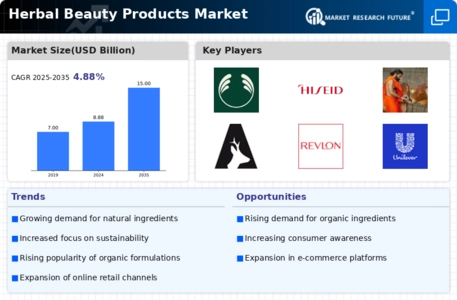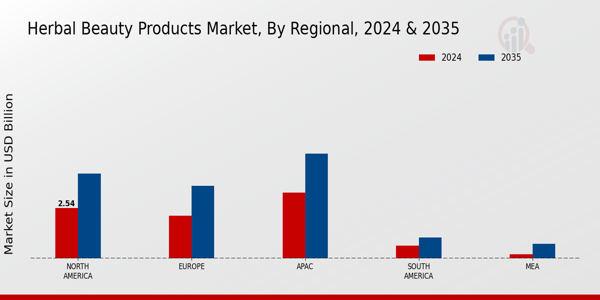Market Growth Projections
The Global Herbal Beauty Products Market Industry is poised for substantial growth, with projections indicating a market value of 8.88 USD Billion in 2024 and an anticipated rise to 15 USD Billion by 2035. This growth is underpinned by a compound annual growth rate of 4.88% from 2025 to 2035, reflecting a sustained interest in herbal beauty solutions. The increasing consumer preference for natural and organic products, coupled with the expansion of distribution channels, positions the herbal beauty sector as a dynamic and evolving market. As brands adapt to changing consumer demands, the industry is likely to witness further innovations and product developments.
Rise of E-commerce Platforms
The Global Herbal Beauty Products Market Industry is significantly influenced by the rise of e-commerce platforms, which facilitate easier access to a diverse range of herbal products. Online shopping has transformed consumer purchasing behavior, allowing brands to reach a global audience without the constraints of traditional retail. This shift is particularly advantageous for niche herbal brands that may struggle to find shelf space in physical stores. As e-commerce continues to expand, it is projected that the market will grow to 15 USD Billion by 2035, highlighting the potential for increased sales and brand visibility in the digital landscape.
Expansion of Herbal Product Lines
The Global Herbal Beauty Products Market Industry is characterized by the expansion of product lines that cater to a diverse range of consumer needs. Brands are increasingly introducing new herbal formulations that address various beauty concerns, from skincare to haircare. This diversification not only attracts a broader customer base but also enhances brand loyalty as consumers find solutions that resonate with their specific requirements. The market's growth trajectory, with an estimated value of 8.88 USD Billion in 2024, suggests that companies that innovate and expand their herbal offerings will likely benefit from increased sales and market share.
Increased Focus on Personalization
The Global Herbal Beauty Products Market Industry is witnessing a shift towards personalized beauty solutions, as consumers seek products tailored to their specific needs and preferences. This trend is driven by advancements in technology, allowing brands to offer customized formulations based on individual skin types and concerns. As personalization becomes a key differentiator in the market, companies that invest in research and development to create bespoke herbal products may gain a competitive edge. This focus on personalization aligns with the broader market growth, as the industry is projected to reach 15 USD Billion by 2035, indicating a strong consumer preference for tailored beauty experiences.
Growing Demand for Natural Ingredients
The Global Herbal Beauty Products Market Industry experiences a notable surge in demand for natural ingredients, driven by increasing consumer awareness regarding the harmful effects of synthetic chemicals. As consumers become more health-conscious, they gravitate towards products that are perceived as safer and more environmentally friendly. This trend is reflected in the market's projected growth, with an estimated value of 8.88 USD Billion in 2024, indicating a robust interest in herbal formulations. Brands that emphasize transparency in sourcing and production are likely to capture a larger share of this evolving market, appealing to a demographic that prioritizes sustainability and ethical practices.
Influence of Social Media and Digital Marketing
The Global Herbal Beauty Products Market Industry is increasingly shaped by the influence of social media and digital marketing strategies. Brands leverage platforms like Instagram and TikTok to engage with consumers, showcasing product benefits through visually appealing content. This trend not only enhances brand awareness but also fosters community engagement, as users share their experiences and recommendations. The effectiveness of these marketing strategies is evident in the market's anticipated compound annual growth rate of 4.88% from 2025 to 2035, suggesting that brands that effectively utilize social media will likely see sustained growth and consumer loyalty.























Leave a Comment